11264 AN INTERESTING MAHOGANY AND BRASS MOUNTED FIVE FOLD SCREEN, POSSIBLY FROM THE TUILERIES PALACE French. Late Eighteenth or Early Nineteenth Century. Measurements: Height: 34 3/4″ (88.2 cm); Width fully extended: 81 1/4 (206.3 cm); Width closed: 16 1/4″ (41.2 cm); Depth: 1″ (2.5 cm).
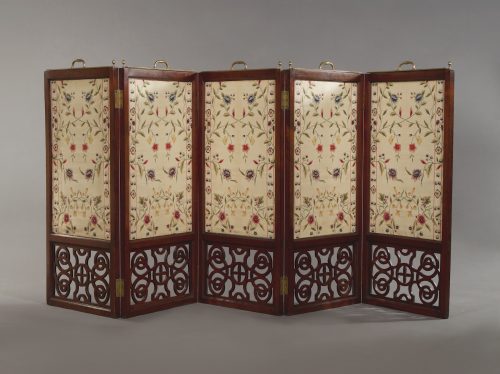
Research
Of mahogany. Comprised of five panels, the upper section of each decorated by later floral painted fabric and adjustable in height by means of a brass handle on the top and ratcheted brass strips on the sides. The lower section of each panel carved with geometric fretwork. Fabric old but not original.
This folding firescreen screen comprises five panels, the upper sections of which can be raised or lowered independently of each other by means of a brass handle on the top and ratcheted brass strips on the sides. Geometric fretwork panels form the lower section of the screen.
Fixed and adjustable screens first appeared in the seventeenth century, and became staple furniture pieces in the houses of the wealthy and middle class. Their main purpose was to shield a person “from the fierce heat of [an] open fire, and the keen and still more disagreeable draughts from open doors,”1 but the varied forms and materials used caused them to become decorations in their own right, particularly as a vehicle for display of needlework. In this unusual example the extremely finely worked ratcheted mechanisms allow the fabric panels to be moved individually to different heights. This ability to adjust the panels was an added luxury; the 1788 Cabinetmakers London Book of Prices and Designs for Cabinet Work itemizes the feature for folding fire screens whereby “making panels to slide” and “if made to slide through the top rail” would cost an additional one to two shillings per panel.2 It is possible this function also allowed for the screen to be adapted to seasonal changes in interior textiles when rugs, furniture suites and curtains were replaced according to summer or winter use.
The present screen is almost identical to a Louis XVI five-fold draught screen sold at Sotheby’s London, 20 November 1964, Lot 127, which is branded with the three fleur-de-lis below a Royal Crown and the mark of the Tuileries, corresponding to the Restauration period. The Sotheby’s screen also has adjustable frames in the upper part, and shares an identical fretwork lower section with the present piece (figure 1).
A further French screen in the art trade, of nearly identical proportions to the present piece, also boasts an impressive aristocratic provenance. It is branded of the inventory mark of the Château de Chanteloup when the house was owned by the duc de Penthièvre. The duc de Penthièvre acquired the château from the estate of the duc de Choiseul in 1786, along with many of its original furnishings. Although it comprises four panels rather than five, the format of the Chanteloup screen corresponds; the upper section of each panel contains double sided Chinese watercolors, while the bottom portion is in the form of open trelliswork in the Chinese style (figure 2).
The unusual geometric fretwork of the present screen aligns with some contemporary furnishings produced for important French residences of the day. Mainly consisting of chairs, this feature is included on a pair of giltwood voyeuses by Jean-Baptiste Claude Sené for the Château de Montreuil (figure 3), examples by Jean Baptiste Boulard (figure 4), and several versions in both giltwood and mahogany at Saint Cloud and Versailles attributed to George Jacob (figure 5). The theory behind the fascinating complicated geometry of the group is uncertain, although it may be an allusion to the complex patterns that existed in the Ottoman applied arts and architecture, which was so fashionable in the reign of Louis XVI. However, Guillaume Janneau proposes that the design for a chaise de bureau by Jacob, in particular, has its roots in Anglomania, specifically tracery patterns as evidenced in the internationally influential work of Thomas Chippendale, via his widely disseminated Gentleman and Cabinet-Maker’s Director of 1754.3
Footnotes:
1. “Screens and Their Uses.” The Furniture Gazette. London, 1882. 119.
2. The Cabinetmakers London Book of Prices and Designs for Cabinet Work… London Society of Cabinet Makers, 1788. 211.
3. Janneau, Guillaume. Le Mobilier Français: Les Sièges. Paris: Flammarion, 1928.

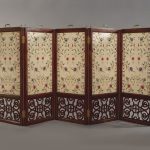

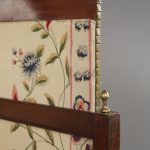
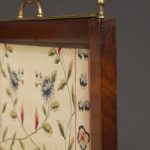
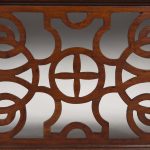

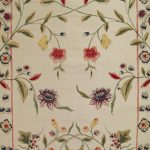
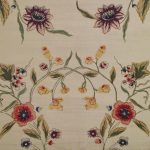

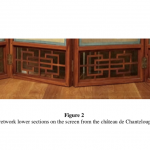

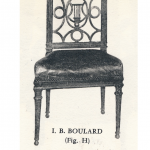
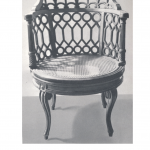
Comments are closed.